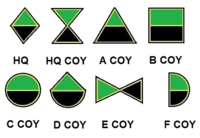Duke of Edinburgh's Own Rifles
| Cape Town Rifles "Dukes" | |
|---|---|

SANDF Cape Town Rifles emblem
|
|
| Active | 28 November 1855 to present |
| Country |
|
| Allegiance | |
| Branch | |
| Type | Infantry |
| Role | Motorised infantry |
| Size | One battalion |
| Part of |
South African Infantry Formation Army Conventional Reserve |
| Garrison/HQ | Cape Town |
| Motto(s) | Semper Eadem |
| Anniversaries | 28 November (Regimental Day) |
| Commanders | |
| Current commander |
Lt Col Francois Marais MMM, B Mil |
| Honorary Colonel | Colonel Les Masterson |
| Insignia | |
| Company level Insignia |  |
| SA Motorised Infantry beret bar circa 1992 |
 SA Motorised Infantry beret bar |
The Cape Town Rifles (nicknamed Dukes) is an infantry regiment of the South African Army. As a reserve unit, it has a status roughly equivalent to that of a British Army Reserve or United States Army National Guard unit.
The Regiment was founded on 28 November 1855, as the Cape Rifle Corps. It was the first volunteer unit in the Cape Colony. It was also known as the "Cape Royal Rifles", and later as the "Cape Town Volunteer Rifles". On 30 September 1867, Prince Alfred, Duke of Edinburgh granted the CTVR the title "Duke of Edinburgh's Own", after it had formed a guard of honour for him during a visit to Cape Town. The nickname "the Dukes" appears to have come into use in the 1880s.
The Regiment's original purpose was home defence, to supplement the British Army garrison which was stationed in Cape Town. It initially consisted of two companies, but later grew to five, the fifth (formed in 1859) being a Scottish company. The Scottish company left the Regiment, and became a unit in its own right, in 1861, and disbanded in 1866. During the depression of the 1860s and early 1870s, the Regiment shrank to only one company, and was one of the few volunteer units to remain in existence
On the outbreak of the 9th Frontier War in 1877, the Regiment volunteered for active service, and fielded a small contingent which served in the Transkei from October 1877 to January 1878. Hundreds of volunteers joined the Regiment, and it was reorganised in April 1878, into six companies. Another contingent served in the Transkei from February to May 1879, to take the place of a British garrison unit which had been re-deployed to Zululand because of the Anglo-Zulu War.
Half the Regiment served in the Basutoland Gun War in Basutoland (now Lesotho) from September 1880 to March 1881, and it was there that the Regiment suffered its first casualties.
...
Wikipedia
